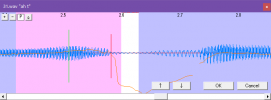So I’ve been trying to make a CVVC English bank, and I’ve noticed that VC otos are all aliased like “V C” instead of “VC”. Does this have any particular meaning?
Also, when otoing certain plosives like “b” or “g”, according to Delta I should oto them in a unique way so as to not encompass the entire consonant in VC oto, and only the breath before the consonant. But according to a guide by Cz I found later, I’m supposed to include the consonant just like I would for any other non-plosive VC oto. Which is it? Which is more recommended? I’m assuming Cz’s because she’s a native speaker, but Teto’s VB which I’m using as reference uses Delta’s method, and I just want to be sure.
Also, when otoing certain plosives like “b” or “g”, according to Delta I should oto them in a unique way so as to not encompass the entire consonant in VC oto, and only the breath before the consonant. But according to a guide by Cz I found later, I’m supposed to include the consonant just like I would for any other non-plosive VC oto. Which is it? Which is more recommended? I’m assuming Cz’s because she’s a native speaker, but Teto’s VB which I’m using as reference uses Delta’s method, and I just want to be sure.



![[K] of Honor](/data/medal/1_1406930084l.jpg)


